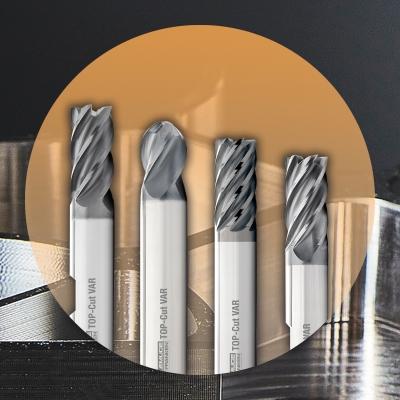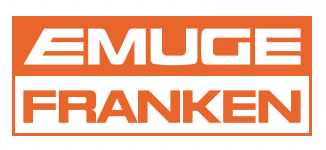
EMUGE-FRANKEN USA, a leading manufacturer of high-performance end mills, taps, thread mills, drills, and other rotary tools, has significantly expanded the range of TOP-Cut VAR, its most popular multi-purpose high performance end mills. Featuring unique geometry and coating, TOP-Cut VAR end mills are the most versatile variable helix carbide solution in the industry, as equally effective in multiple job shop applications as they are in challenging production cutting operations.
The TOP-Cut VAR line is now available in 4,5, and 6-flute configurations, with or without corner radius, and ball nose, stub, standard and long lengths in inch sizes, over 300 SKU’s in total. In addition, EMUGE-FRANKEN USA can provide custom variations or tool modifications of TOP-Cut VAR mills.
“Our TOP-Cut VAR tools are the best choice for manufacturers who need flexibility and performance,” said Mr. Dan Doiron, EMUGE-FRANKEN USA Milling Products Manager. “In addition, we are now manufacturing these end mills at our North American headquarters in West Boylston, MA U.S.A. to stringent EMUGE-FRANKEN Germany specifications and standards.”
TOP-Cut VAR end mills feature unique flute and profile geometries optimized for long tool life and superior performance in both roughing and finishing applications. Variable helix angle flutes provide extensive vibration dampening and are precision ground with advanced edge preparation to maximize chip evacuation. A chamfer feature protects cutting edges to prevent chipping, and end mills with fully blended corner radiuses extend tool life, while providing improved surface finishes. All TOP-Cut VAR end mills have an advanced ALCR PVD coating that enables outstanding performance and extended life in higher operating temperatures, and a proprietary sub-micro grain carbide provides maximum abrasion resistance and durability.
Contact Details
Related Glossary Terms
- edge preparation
edge preparation
Conditioning of the cutting edge, such as a honing or chamfering, to make it stronger and less susceptible to chipping. A chamfer is a bevel on the tool’s cutting edge; the angle is measured from the cutting face downward and generally varies from 25° to 45°. Honing is the process of rounding or blunting the cutting edge with abrasives, either manually or mechanically.
- flutes
flutes
Grooves and spaces in the body of a tool that permit chip removal from, and cutting-fluid application to, the point of cut.
- gang cutting ( milling)
gang cutting ( milling)
Machining with several cutters mounted on a single arbor, generally for simultaneous cutting.
- helix angle
helix angle
Angle that the tool’s leading edge makes with the plane of its centerline.
- milling
milling
Machining operation in which metal or other material is removed by applying power to a rotating cutter. In vertical milling, the cutting tool is mounted vertically on the spindle. In horizontal milling, the cutting tool is mounted horizontally, either directly on the spindle or on an arbor. Horizontal milling is further broken down into conventional milling, where the cutter rotates opposite the direction of feed, or “up” into the workpiece; and climb milling, where the cutter rotates in the direction of feed, or “down” into the workpiece. Milling operations include plane or surface milling, endmilling, facemilling, angle milling, form milling and profiling.
- physical vapor deposition ( PVD)
physical vapor deposition ( PVD)
Tool-coating process performed at low temperature (500° C), compared to chemical vapor deposition (1,000° C). Employs electric field to generate necessary heat for depositing coating on a tool’s surface. See CVD, chemical vapor deposition.

